Domestic television game console "Astra" - greetings from the 90s
It's time to get old Astra from the attic and talk a little about her, look inside.
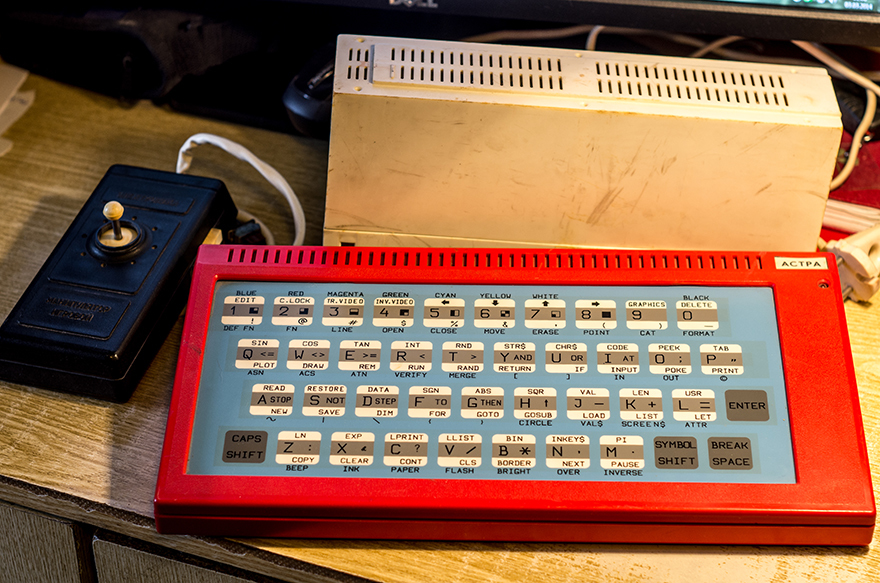
So, "Astra . " The set consisted of: the main block keyboard, the game controller "Electronics", a power supply unit, several connecting wires, a pair of reels with games (after some time they were rewritten to audio cassettes), an instruction manual, a brochure describing the commands of the Basic language and examples all sorts of different programs.
Computing block.
Represents the "touch" keyboard of those years. The contact of the buttons was closed by forcing the upper surface. I want to note that this is not the best keyboard for programming, but it looked very unusual. Most of the "keys" have 5-6 values, and sometimes it took quite a long time to find the desired value from the code. Presses were heard through the TV. I would also like to note that the TV "Birch" had to be upgraded to make it possible to use the console.
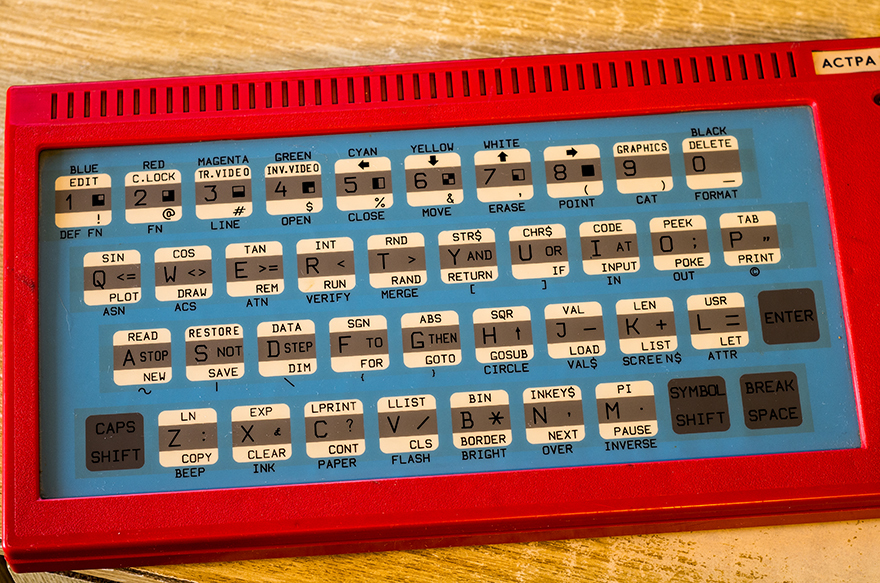
Inside we are waiting for: a Zilog Z80 processor , two K573RF4A RPZUs (about this device below with macro photos ) and a dozen or four logic. I had an Astra at the age of seven, and K573RF4A already then attracted with its appearance.
Zilog z80- An eight-bit microprocessor with a clock frequency of 2.5 MHz ( Wiki )
K573RF4A - Reprogrammable ROM. Information is erased using ultraviolet radiation (up to 20 minutes of irradiation), recording and programming - by electricity. The volume of K573RF4A is 64 Kilobits (more: characteristics and mechanism )

Game manipulator - "Electronics".
Made in the domestic style;) with a domestic connector. The same connector was used for the TV.
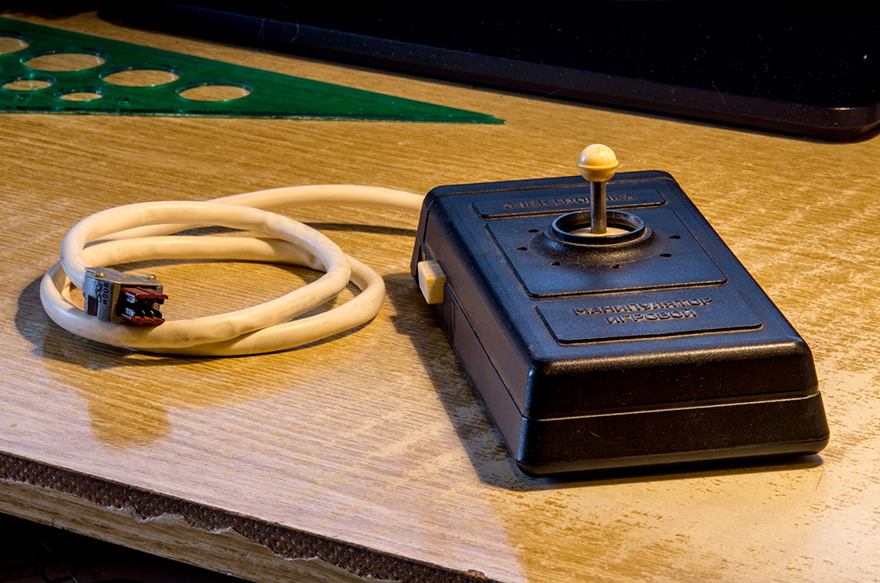
Implemented on reed switches. The lever on the spring hinge, which ensures a return to the neutral position. Magnetic ring at the base of the lever.
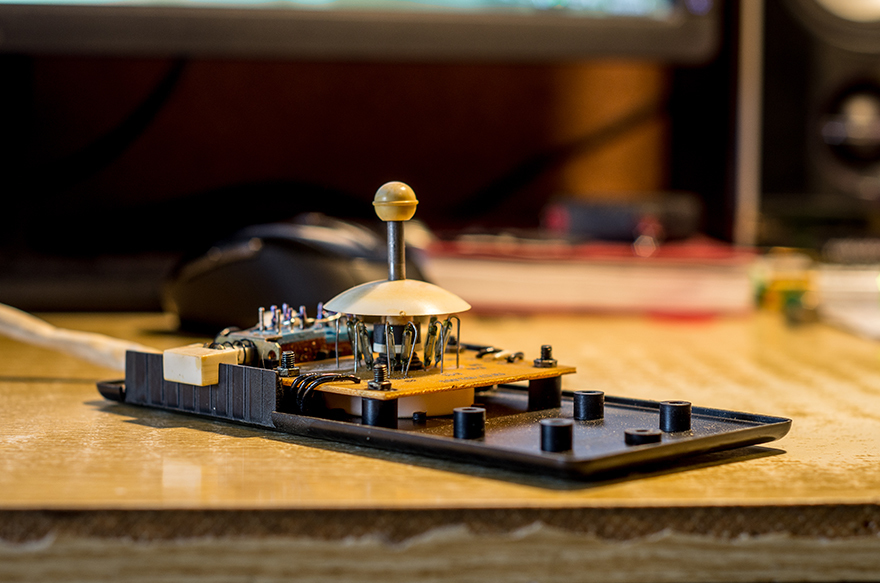
For direct directions (left, right, top, bottom), one reed switch is used, for diagonal (left-bottom, etc.), for some reason, two are used. Perhaps to operate in narrower positions of the lever.

A couple of years after Astra (1990-1991), Dendy, Sega and other consoles began to appear. Someone will recall gaming clubs with similar consoles like Astra (Spectrum and other analogues). Surely, the most popular game in such clubs were airplanes. The games were different, most of them were arcades, rarely there were “three-dimensional” arcades, and, of course, old Pakman. Of the examples of programs presented in the manual, there were all kinds of colorful animations, all kinds of divers who sank to the bottom of the sea (I can’t find a bookstore, I would take a couple of pictures).
Astra gathered at the Robot Small Enterprise in Minsk
Let us return to the K573RF4A device .

Engineering beauty ...
It has already been written that the K573RF4A is a 64 kbit (8k x 8) reprogrammable
Read Only Memory with ultraviolet erasure and electrical recording of information. Contains 169579 integral elements.
Has an eight-bit organization, with the simultaneous reading of 8 bits.
The letter size is roughly roughly 58 microns. What this labeling means, I did not find on the network. RF86P or RFVBP.
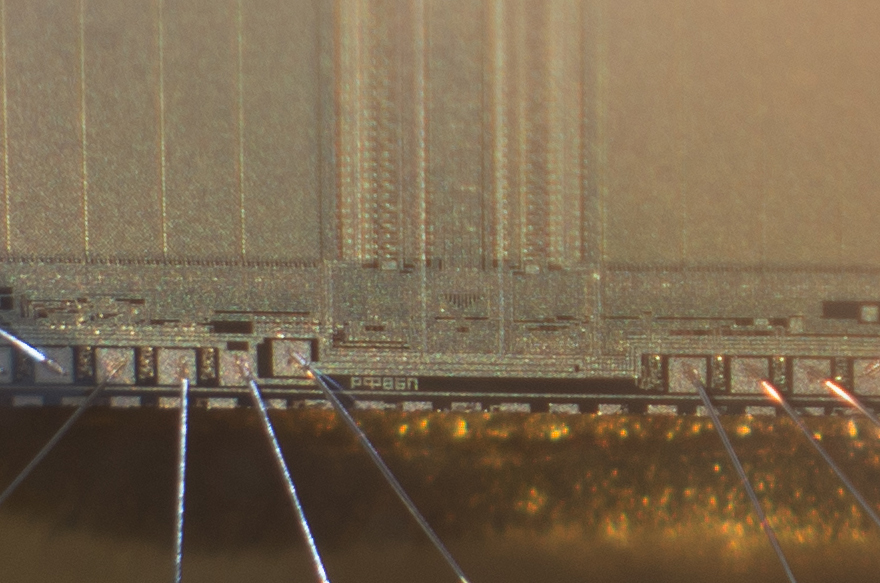
The structure of the storage matrix with memory cells :

Excerpt from the lecture :
ROM with ultraviolet erasure is based on a storage matrix built on memory cells, the internal device of which is shown in the following figure:

The cell is a MOS transistor in which the gate is made of polycrystalline silicon. Then, during the manufacture of the microcircuit, this gate is oxidized and as a result it will be surrounded by silicon oxide - a dielectric with excellent insulating properties. In the described cell, when the ROM is completely erased, there is no charge in the floating gate, and therefore the current transistor does not conduct. When programming the microcircuit, a second voltage, located above the floating gate, is supplied with high voltage and charges are induced into the floating gate due to the tunnel effect. After removing the programming voltage on the floating gate, the induced charge remains and, therefore, the transistor remains in a conducting state. A charge on a floating shutter can be stored for decades. The block diagram of the permanent storage device does not differ from the previously described masked ROM. Only the jumper described above is used instead of the jumper. In reprogrammable ROMs, erasure of previously recorded information is carried out by ultraviolet radiation. In order for this light to freely pass to the semiconductor crystal, a quartz glass window is built into the microcircuit housing.
When the microcircuit is irradiated, the insulating properties of silicon oxide are lost and the accumulated charge from the floating gate flows into the semiconductor volume and the storage transistor goes into the closed state. The erase time of the microcircuit ranges from 10 to 30 minutes.
The number of write-erase cycles of the microcircuit is in the range from 10 to 100 times, after which the microcircuit fails. This is due to the damaging effects of ultraviolet radiation. These microcircuits most often store BIOS programs for universal computers.
From different lighting angles, you can consider the multi-level paths of the tracks.

Microelectronics, what can I say.
Thanks.

So, "Astra . " The set consisted of: the main block keyboard, the game controller "Electronics", a power supply unit, several connecting wires, a pair of reels with games (after some time they were rewritten to audio cassettes), an instruction manual, a brochure describing the commands of the Basic language and examples all sorts of different programs.
Computing block.
Represents the "touch" keyboard of those years. The contact of the buttons was closed by forcing the upper surface. I want to note that this is not the best keyboard for programming, but it looked very unusual. Most of the "keys" have 5-6 values, and sometimes it took quite a long time to find the desired value from the code. Presses were heard through the TV. I would also like to note that the TV "Birch" had to be upgraded to make it possible to use the console.

Inside we are waiting for: a Zilog Z80 processor , two K573RF4A RPZUs (about this device below with macro photos ) and a dozen or four logic. I had an Astra at the age of seven, and K573RF4A already then attracted with its appearance.
Zilog z80- An eight-bit microprocessor with a clock frequency of 2.5 MHz ( Wiki )
K573RF4A - Reprogrammable ROM. Information is erased using ultraviolet radiation (up to 20 minutes of irradiation), recording and programming - by electricity. The volume of K573RF4A is 64 Kilobits (more: characteristics and mechanism )

Game manipulator - "Electronics".
Made in the domestic style;) with a domestic connector. The same connector was used for the TV.

Implemented on reed switches. The lever on the spring hinge, which ensures a return to the neutral position. Magnetic ring at the base of the lever.

For direct directions (left, right, top, bottom), one reed switch is used, for diagonal (left-bottom, etc.), for some reason, two are used. Perhaps to operate in narrower positions of the lever.

A couple of years after Astra (1990-1991), Dendy, Sega and other consoles began to appear. Someone will recall gaming clubs with similar consoles like Astra (Spectrum and other analogues). Surely, the most popular game in such clubs were airplanes. The games were different, most of them were arcades, rarely there were “three-dimensional” arcades, and, of course, old Pakman. Of the examples of programs presented in the manual, there were all kinds of colorful animations, all kinds of divers who sank to the bottom of the sea (I can’t find a bookstore, I would take a couple of pictures).
Astra gathered at the Robot Small Enterprise in Minsk
Let us return to the K573RF4A device .

Engineering beauty ...
It has already been written that the K573RF4A is a 64 kbit (8k x 8) reprogrammable
Read Only Memory with ultraviolet erasure and electrical recording of information. Contains 169579 integral elements.
Has an eight-bit organization, with the simultaneous reading of 8 bits.
The letter size is roughly roughly 58 microns. What this labeling means, I did not find on the network. RF86P or RFVBP.

The structure of the storage matrix with memory cells :

Excerpt from the lecture :
ROM with ultraviolet erasure is based on a storage matrix built on memory cells, the internal device of which is shown in the following figure:

The cell is a MOS transistor in which the gate is made of polycrystalline silicon. Then, during the manufacture of the microcircuit, this gate is oxidized and as a result it will be surrounded by silicon oxide - a dielectric with excellent insulating properties. In the described cell, when the ROM is completely erased, there is no charge in the floating gate, and therefore the current transistor does not conduct. When programming the microcircuit, a second voltage, located above the floating gate, is supplied with high voltage and charges are induced into the floating gate due to the tunnel effect. After removing the programming voltage on the floating gate, the induced charge remains and, therefore, the transistor remains in a conducting state. A charge on a floating shutter can be stored for decades. The block diagram of the permanent storage device does not differ from the previously described masked ROM. Only the jumper described above is used instead of the jumper. In reprogrammable ROMs, erasure of previously recorded information is carried out by ultraviolet radiation. In order for this light to freely pass to the semiconductor crystal, a quartz glass window is built into the microcircuit housing.
When the microcircuit is irradiated, the insulating properties of silicon oxide are lost and the accumulated charge from the floating gate flows into the semiconductor volume and the storage transistor goes into the closed state. The erase time of the microcircuit ranges from 10 to 30 minutes.
The number of write-erase cycles of the microcircuit is in the range from 10 to 100 times, after which the microcircuit fails. This is due to the damaging effects of ultraviolet radiation. These microcircuits most often store BIOS programs for universal computers.
From different lighting angles, you can consider the multi-level paths of the tracks.

Microelectronics, what can I say.
Thanks.
